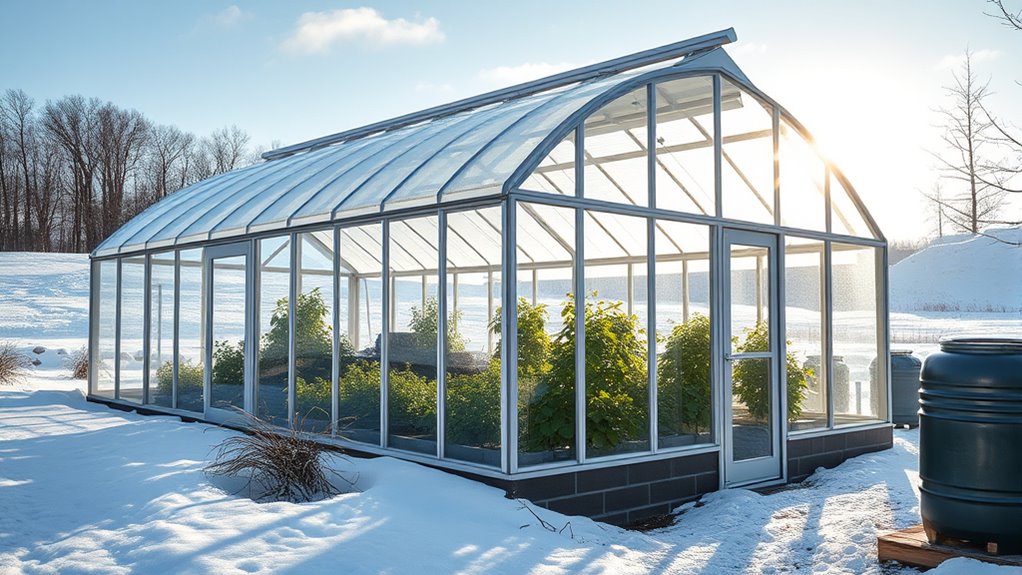To design a passive solar greenhouse for winter efficiency, you should position it facing south in the northern hemisphere for maximum sunlight capture, using high-quality glazing like double or triple-pane glass. Incorporate thermal mass such as concrete or water containers to store heat, and make certain proper sealing and insulation to reduce heat loss. Control ventilation and consider shading devices to prevent overheating, all working together to optimize warmth without extra energy. Exploring these tips further can help you create an effective winter-ready greenhouse.
Key Takeaways
- Orient the greenhouse south in the northern hemisphere to maximize sunlight capture during winter.
- Incorporate high-insulation glazing like double or triple-pane glass to reduce heat loss.
- Use thermal mass materials such as concrete or water containers on the south side to absorb and release heat.
- Seal gaps and insulate structural elements to prevent heat escape and maintain stable internal temperatures.
- Include shading devices and thermal curtains to regulate temperatures and prevent overheating during warm days.

Designing a passive solar greenhouse allows you to maximize natural heating and cooling, reducing energy costs and environmental impact. To achieve this, you need to pay close attention to how you manage heat within the structure. One of the most effective ways to do this is by incorporating thermal mass. Thermal mass acts as a heat reservoir, absorbing warmth during the day and releasing it slowly at night, helping maintain a stable temperature inside your greenhouse. You might use materials like concrete, stone, or water containers strategically placed to absorb daytime heat and radiate it back during colder hours. Proper placement of thermal mass is essential; placing it on the south side where it gets maximum sunlight ensures it absorbs the most heat when the sun is strongest.
Incorporate thermal mass on the south side to absorb and radiate heat effectively.
Equally important is your glazing selection. The type and quality of glazing directly influence how much solar radiation enters your greenhouse and how well that heat is retained. Clear, high-quality glazing like double or triple-pane glass provides excellent transparency and insulates effectively, reducing heat loss during winter nights. Low-iron glass can maximize sunlight transmission, ensuring your plants get the light they need while minimizing thermal escape. Alternatively, polycarbonate panels or specialized greenhouse films can be effective, especially if they are designed for high insulation. When choosing glazing, consider both its solar gain and its insulating properties; the goal is to allow maximum sunlight in during winter while limiting heat loss.
You should also think about the orientation of your greenhouse, ideally aligning it to face south in the northern hemisphere. This setup guarantees you capture the most sunlight during winter months, further boosting your passive heating. The combination of proper glazing selection and thermal mass placement enhances the greenhouse’s ability to harness the sun’s energy efficiently.
Furthermore, sealing gaps and ensuring proper insulation around doors and vents help retain the heat you gain. Ventilation should be carefully controlled to prevent overheating on sunny days but also to avoid excessive heat loss at night. Incorporating shading devices or thermal curtains can help regulate internal temperatures, especially during unexpected warm spells.
Frequently Asked Questions
How Do I Prevent Frost Damage in a Passive Solar Greenhouse?
To prevent frost damage in your passive solar greenhouse, you should use thermal curtains at night to insulate and retain heat. These curtains act as frost protection, trapping warmth inside and preventing cold air from reaching your plants. make certain you close them when temperatures drop, especially during clear, cold nights. Additionally, monitor the weather forecast to anticipate frost conditions, and consider extra insulation or heating options if necessary.
What Are the Best Materials for Insulation in Winter?
You should prioritize using double glazing for your greenhouse windows, as it provides excellent insulation and reduces heat loss. Additionally, incorporate foam insulation in the walls and foundation to boost thermal efficiency. These materials work together to keep your greenhouse warm during winter, preventing frost damage. Make sure to seal all gaps and consider adding a thermal blanket at night for ideal winter insulation, ensuring your plants stay protected and healthy.
How Can I Optimize Ventilation Without Losing Heat?
You can optimize ventilation without losing heat by using strategic ventilation strategies like vent placement near the ceiling and adjustable vents. Installing automated vent openers helps control airflow based on temperature, maintaining heat retention. Additionally, consider adding thermal curtains or insulation baffles to reduce heat loss during ventilation. These methods guarantee fresh air enters while keeping heat inside, balancing airflow with energy efficiency for winter greenhouse success.
What Is the Ideal Orientation for Winter Sunlight?
Imagine harnessing the sun’s power at its peak—your greenhouse should face true south, maximizing winter sunlight. To enhance efficiency, use strategic window placement and consider solar tracking devices to follow the sun’s arc. This setup traps warmth during the day and minimizes heat loss at night, ensuring your greenhouse stays cozy. The right orientation and window positioning reveal the secret to winter warmth, transforming your space into a solar sanctuary.
How Do I Manage Humidity Levels Effectively?
You should monitor humidity levels regularly to maintain ideal plant health and prevent mold. Use a hygrometer to track humidity, aiming for 50-60%. If it’s too high, increase ventilation or add a dehumidifier; if it’s too low, mist plants or install a humidifier. Proper humidity control guarantees your plants thrive and reduces disease risk, creating a healthy environment inside your greenhouse.
Conclusion
By designing your passive solar greenhouse with careful attention to insulation and sun placement, you’ll naturally create a space that stays warm all winter. It’s almost like the sun and your efforts align perfectly, working together to keep your plants thriving. When you see how the sun’s path influences your greenhouse’s warmth, it feels like the universe is helping you grow. With a little planning, winter gardening becomes not just possible, but effortless.









